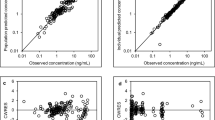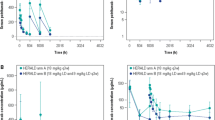Abstract.
Purpose: As vinorelbine is 78% bound to platelets, it seems interesting to investigate the pharmacokinetic profile of this drug from blood and to compare it to that determined from plasma. Thus, in this study, the comparative blood/plasma pharmacokinetics of vinorelbine were investigated in 15 elderly patients with advanced metastatic cancer. Methods: The drug was given as a short (10 min) peripheral intravenous infusion; the administered dose ranged from 20 to 30 mg/m2 depending on the patient. Chemotherapy was repeated weekly. During the first and the fifth courses, each patient underwent pharmacokinetic evaluation. Toxicity evaluation was performed after each course of chemotherapy; a total of 109 courses was studied. Plasma and blood vinorelbine determinations were performed by high-performance liquid chromatography with spectrofluorimetric detection. Individual pharmacokinetic parameters were estimated with an empirical Bayes methodology. An open three-compartment pharmacokinetic model was used to describe the kinetics of vinorelbine. Results: The half-lives of the terminal part of the curves, determined from blood and plasma data, were of the same order of magnitude: 31–35 h. Mean total clearances were about 0.71 l/h/kg from plasma and 0.45 l/h/kg from blood. Except during the first 15–20 min following the end of infusion, vinorelbine concentrations were 1.9 times higher in blood than in plasma. The ratio AUCB/AUCP (AUCB and AUCP are the area under the concentration–time curve from blood and plasma data, respectively) averaged 1.7; it was comparable to the blood/plasma ratio of 1.6 that remained constant over the 72 h of the study. There was substantial intra- and interpatient variability in vinorelbine pharmacokinetic parameters. This variability is similar within and between patients, and between pharmacokinetic parameters computed from blood and plasma. The elimination half-life is the parameter with the lowest intra- and interindividual variability (10–14%), while the AUC is the parameter presenting the highest variability (20–65%). The main haematological toxicity was anaemia (12 patients) and neutropenia (10 patients). Thrombocytopenia occurred in only one patient. At the first cycle, significant correlations were found between AUCB and AUCP and the decrease in neutrophil count (P<0.05). The highest haematological toxicities encountered in this study occurred in patients presenting the lowest platelet count. AUC computed from plasma data decreased significantly with the increase of platelet count (P=0.03). Conclusion: From the results of this study, blood did not appear to be a better predictor of haematological toxicity than plasma, but the decrease of platelet count seems to be a good predictor of this toxicity. Indeed, changes in platelet count are likely to produce strong variations in the unbound fraction of vinorelbine; this exposes the patient to a high risk of toxicity.
Similar content being viewed by others
Author information
Authors and Affiliations
Additional information
Electronic Publication
Rights and permissions
About this article
Cite this article
Gauvin, A., Pinguet, F., Culine, S. et al. Blood and plasma pharmacokinetics of vinorelbine in elderly patients with advanced metastatic cancer. Cancer Chemother Pharmacol 49, 48–56 (2002). https://doi.org/10.1007/s00280-001-0378-2
Received:
Accepted:
Issue Date:
DOI: https://doi.org/10.1007/s00280-001-0378-2




